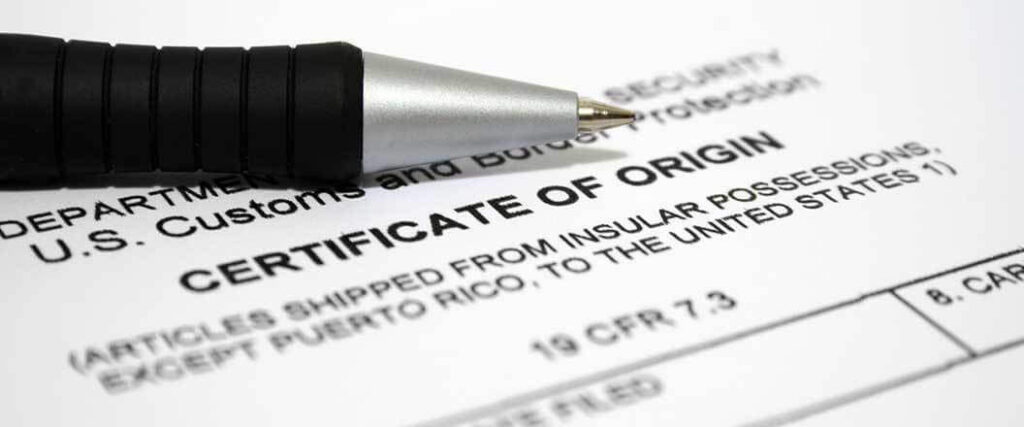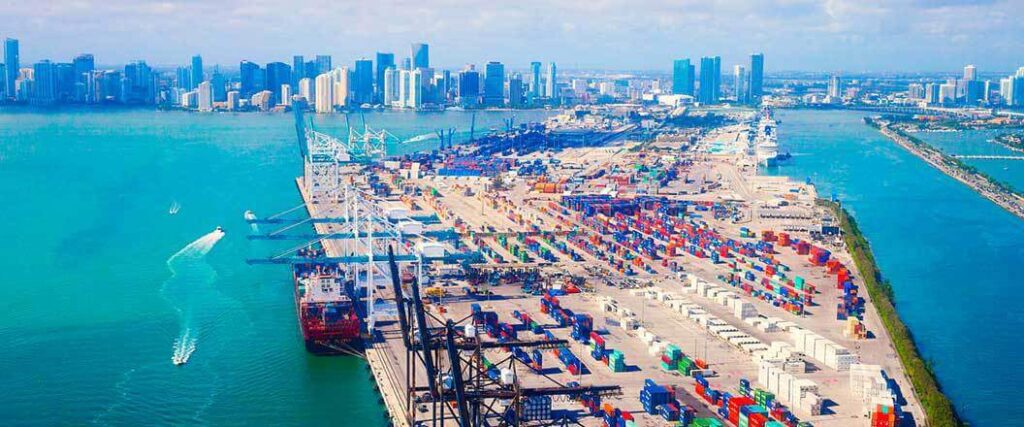What is a Certificate of Origin for Export? This is a question many new and even experienced international sellers in the U.S. ask. Buyers in foreign countries commonly request exporters to include this document with their shipment of cargo. Therefore, it’s important for businesses to understand what this document is and how it can help their operations.
According to the World Trade Organization (WTO), a certificate of origin (CO) for export is a crucial document that certifies the country where the goods or commodities were manufactured. Buyers in countries that share a Free Trade Agreement (FTA) with the U.S. will request this document to apply for preferential tariff treatment.
Before businesses send their exports to another country, they should first know how to obtain this important document.
A CO is a key document that verifies the country where goods were manufactured or produced. Essentially, this document services as a birth certificate for exported products.
COs have the following uses:
There is a standard rate that’s applied to all exported items. Importers in FTA member nations will request COs from U.S. exporters to obtain a cheaper tariff. The requirements to obtain cheaper costs will change depending on the agreement. Therefore, COs will contain slightly different information that satisfies the requirements of the corresponding FTA.
Providing this document for a foreign importer that wants to apply for a preferential duty rate will make their customs clearance experience smoother. Officials in other nations will need to examine this document to make sure the right fees and taxes are applied to the shipment.
Without the CO, foreign importers wouldn’t be able to enjoy a preferential tariff rate and customs clearance would be stalled. According to the International Trade Administration (ITA), the U.S. has 14 FTAs with 20 different countries. Exporters will need to provide a CO if buyers in a partner nation requests one. To show how important FTAs are to U.S. trade, consider the following data.
| FTA | Percentage of Exports |
| NAFTA | 27% |
| South Korea | 3% |
| CAFTA-DR | 1% |
| Singapore | 1% |
| Other FTA Partners | 3% |
Provided by the United Stated International Trade Commission
As the data shows, the U.S. conducts a considerable amount of trade with FTA partner countries. This makes COs extremely significant because it gives exporters better business opportunities in these nations.
If you're working with a foreign national, then consider reading our article on deemed exports.

Certificate of origins for export templates can be obtained from a variety of different sources. The best place for U.S. exporters to obtain this kind of paperwork is from Customs and Border Protection (CBP). That said, it’s essential to note that these documents come in a variety of different formats depending on the FTA.
Some variations include:
In some cases, a CO might not have a specific format. Exporters will need to consult the FTA agreement their foreign buyer wants to apply for preferential tariff treatment under.
Getting a certificate of origin for international shipping is only one responsibility that exporters need to worry about. Once they obtain this document, they will need to take the necessary steps to issue the document.
These steps include:
By following these simple steps, exporters will have all they need to issue a CO.
Completing and notarizing an affidavit is the initial step towards obtaining a certificate of origin for international shipping. This is a legal document where a business attests to the origin of the goods they're exporting. Companies will need to fill out the affidavit with all the necessary details about their products.
This includes:
Once an exporter has completed the affidavit, it must be notarized. This process involves an authorized person (a notary public) who verifies the authenticity of the signature and identity of the person who signed the document. Completing and notarizing an affidavit provides a firm legal basis for an export’s CO.
Providing a commercial or manufacturer's invoice is an important step in obtaining a CO. This document gives additional details about the goods in a shipment. The commercial invoice is a document that outlines the details of a transaction between a seller and a buyer.
It includes information such as:
The manufacturer’s invoice confirms who produced the items in an exported shipment of freight. In addition to verifying the quantity of goods and a description, this document also states how much it cost to make the products. Exporters can use either of these invoices when obtaining a CO.
After an exporter provides an affidavit and an invoice of their choosing, exporters can start filling out their CO. Filling out this document correctly is essential.
COs will require the following information to be provided:
Exporters should check their CO a few times after filling it out to ensure there are no mistakes.
The final step in obtaining a Certificate of Origin for export involves submitting the required documents to the U.S. Chamber of Commerce. The submitted paperwork goes through a verification process where it’s checked for completeness and accuracy. After this is done, the Chamber of Commerce provides their stamp of approval.
If you don’t have an export license, you should know how much it costs before attaining one.

The importance of a Certificate of Origin can't be underestimated when it comes to conducting international trade. This document can aid businesses in their export operations.
This includes:
We’ll explain how using a CO will help exporters in each of these areas of their operations.
Import controls are measures that foreign countries put in place to regulate the goods that enter their markets. Oftentimes, a non-preferential or generic CO is used to satisfy these regulations. This variation of the document cannot be used to apply for a special duty rate. Some goods are restricted or banned from certain countries. The generic CO can be used to ensure such products don’t enter these nations.
Another purpose for import controls is to protect local industries from foreign competition. The non-preferential CO allows importing countries to identify goods that might be subject to protective measures.
COs can significantly expand market access for exporters. Businesses that don’t provide this type of document won’t be able to help foreign buyers that want to apply for preferential tariff treatment. Using a CO helps companies reach markets with FTA member nations and conduct smooth operations.
This document can also help exporters overcome trade barriers, such as:
Since a CO can certify a product's origin, it may help circumvent these barriers. This document can enhance an exporter's credibility by providing verified information about the origin of goods. Building trust with buyers can help businesses sell to importers in these countries because of the transparency the document offers.
COs provide a sense of reassurance and confidence to foreign buyers, as they provide verified information about the origin of goods. This confidence can be crucial in establishing and maintaining international business relationships.
Importers also know that a CO confirms that products come from these regions, indirectly attesting to their quality. This assures importers that the goods they’ll receive are well-made.
Businesses should know when their foreign buyer will request a CO. An importer typically asks an exporter for this document during the negotiation process. When a U.S. seller agrees to provide a CO, they’ll have plenty of time to obtain the paperwork and complete the issuing process.
The document will need to be provided prior to shipping goods to another country. This ensures that foreign customs authorities can examine the CO when the products arrive and can apply the correct duty rate.

Exporters should understand the difference between country of export vs country of origin. These terms may seem similar, but they refer to two different types of nations.
The country of export refers to where the goods are shipped from. This doesn't necessarily mean the goods were produced in this nation. The country of origin is where the goods were made. Likewise, this nation isn’t always the same one that exports the products.
Businesses get these terms confused because the country of export and origin can coincidentally be the same. Therefore, companies should remember that COs are only concerned with determining where goods were produced.
Before you send goods to another country, it’s important you learn about export control basics.
At Cargo Export USA, we can help you obtain and issue your own certificate of origin for export. One of our experts will be able to guide you through the process by showing each step you’ll have to complete. We offer a variety of other services that can be helpful during your export journey.
These include:
If you’re ready to use our services before you ship to another country, then fill out your quote. You can also contact our team at (866) 301-0635 if you have any questions or concerns regarding your shipment of goods.